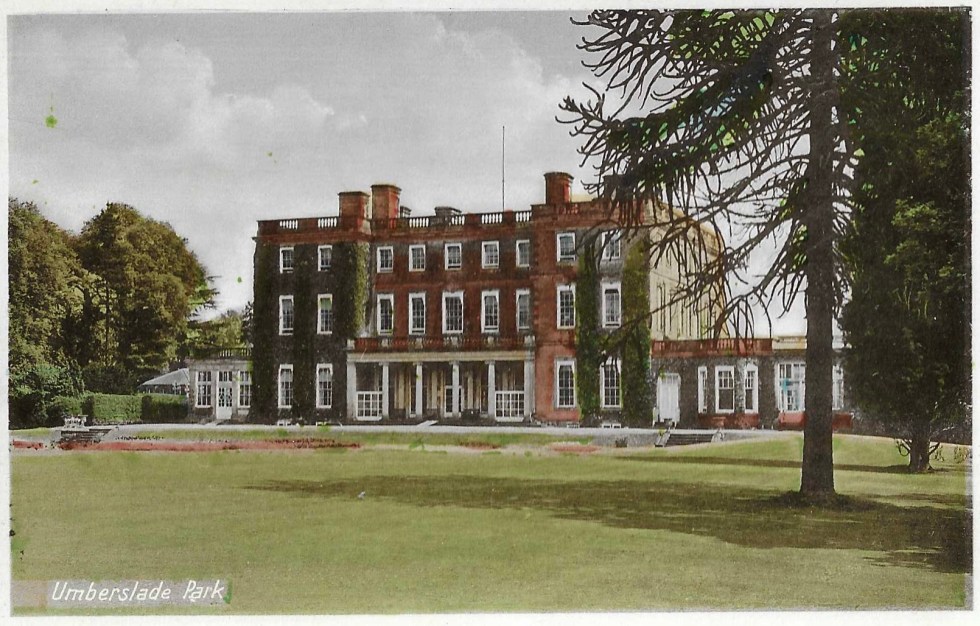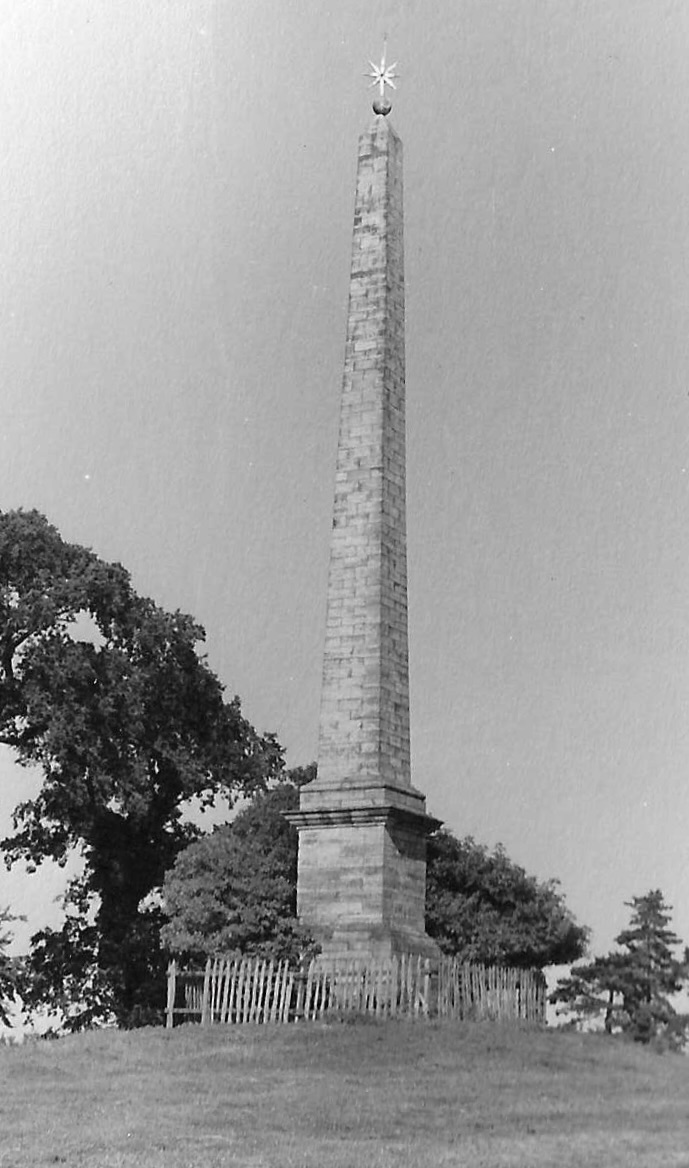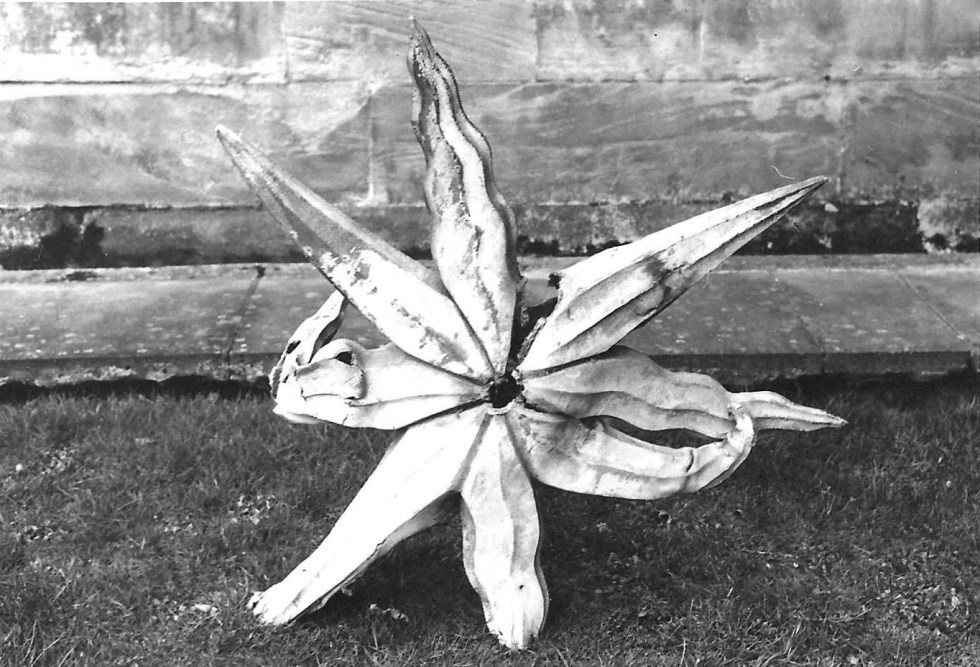If you have driven on the M40 in Warwickshire, you might have caught a glimpse of this obelisk in the former parkland of Umberslade Hall. In the middle of the eighteenth century Umberslade was home to Thomas Archer, who commissioned this obelisk. It was originally topped with an eye-catching golden star which, sadly, is long gone but it is known from old photographs.

The obelisk was erected in 1748-49 to the design of the local architect William Hiorne. It carries no inscription, which means that historians have had to ponder what it might commemorate. The most likely suggestion is that Archer (1695-1768) built it to mark his elevation to the peerage as Baron Archer in 1747. Or perhaps it simply had the double purpose of being a ‘striking object’ from the house, and a reminder to those walking or riding in the park to stop and look back at the mansion and grounds, the view being ‘good from the obelisk’.
Lady Luxborough, of nearby Barrells, took a keen interest in the architectural enterprises of her landed neighbours, and in 1749 wrote to a friend that she was dining with Lord Archer and intended to judge for herself how the obelisk looked from the house – another of her acquaintance had told her it was too tapered to have a good effect. Lady Luxborough also noted that Archer’s obelisk was to carry a finial in the form of a gilded globe and cross.

The ‘cross’, as erected, was more accurately described in a contemporary fragment as a ‘large Star of Lead Gilt’, which would have glistened in the sun, making the obelisk even more of an eye-catcher.
The estate was sold in 1825 by the famed auctioneer George Robins, who is remembered for his sales patter. After the Umberslade sale one paper wrote that they would have to paraphrase his opening remarks, or it would ‘occupy a considerable portion of this column’. Robins became wealthy from his trade and was celebrated as:
George Robins, of auction renown,
Who made a great fortune by knocking things down.
Umberslade Park, complete with ‘Obelisk’, was knocked down to Mr Edward Bolton King. He stayed until 1846 when a change of occupier must have led to a number of famous faces gazing upon the obelisk from the windows of the mansion. The hall became a Hydropathic Establishment under the direction of Dr Edward Johnson, and his patients for the water cure included Alfred Tennyson, Florence Nightingale and Sir Edward Bulwer Lytton.
The lack of inscription gave the community the chance to add their own fanciful histories to the structure. In 1929 the local vicar wrote that one of his parishioners was certain that Lord Archer’s favourite hunter was buried underneath the obelisk, whilst another old resident was convinced it commemorated a member of Lord Archer’s family who had taken their own life. Another source notes that the obelisk is supposed to mark the spot where Warwickshire’s last coven of witches gathered.

The obelisk still carried its sphere and star finial in 1966, but by 1974 the star could be viewed at closer quarters, as it lay crumpled on the ground. Its current whereabouts are unknown: hopefully it is tucked in the corner of a store somewhere, but as it was made of lead the Flâneuse fears it is long gone.

The obelisk remains an eye-catcher, but not for the inhabitants of Umberslade Hall. The mansion was divided into apartments after being sold by the Muntz family, owners of the estate since the late nineteenth century, who continue to own much of the parkland. The M40 cuts between the mansion and the obelisk, and mature trees block the view from the hall. So it is motorists who get the prime view, albeit fleetingly and without the option to linger and appreciate it. You can however leave the motorway and head for Pound House Lane, from where a footpath gets you close to the obelisk (grade II).

Although the base and lower half of the needle were swamped with ivy in the early years of this century, the vegetation has since been cleared and the obelisk looks rather fine.
The Flâneuse acknowledges the work of Dr Michael Cousins, whose article on the early history of the obelisk appeared in Follies (the magazine of the Folly Fellowship) in Spring 2006 (No. 63).
Thank you for reading. As ever, your thoughts are very welcome. Simply scroll down to the comments box at the foot of the page to get in touch.






David Turner Rhodes says:
It has a close resemblance to the obelisk in Ripon Market Place and the gold Horn at the top
Grade 1 LB -1702 John Aislabie funded it. Deemed to be the earliest public obelisk in UK
Editor says:
Hello David. Obelisks with gilded finials are quite fascinating. There are the suns at Stourhead and Windsor for example, both restored and gleaming, and the recently replaced sun at Wentworth Castle. I’m sure there are more to discover. But as you say, Ripon led the way.
Peter Lawford says:
Although I don’t comment very often, I do read and enjoy every new article….. New Brunswick. Canada, but not for the first 55 years… 🙂
Editor says:
Good morning Peter. It is so kind of you to comment and let me know you appreciate the weekly posts. It is always heartening to know that there are people out there reading my ramblings – especially as far away as New Brunswick.
TOM GARDNER says:
MORNING. (TOM NYC)
WHILE OUR MONUMENTS AREN’T EVEN CLOSE, AGE WISE, TO YOURS; FOR THOSE OF US WHO UNDERSTAND AND APPRECIATE THIER SPECIAL HISTORY,
THE ‘MAGIC’ – THAT SET OUR IMAGINATION … ‘ON FIRE’ – IS THE SAME.
WHY EVEN … ‘A FALLEN STAR’ – HAS ITS SPECIAL, MYSTIC POWER.
Editor says:
Good afternoon Tom. I found the photograph of the ‘fallen star’ really quite poignant. I’m pleased that the obelisk is still standing, and in good condition, even without its crowning glory.